Fighting Jim Crow on the High Seas - The Back Story
American seamen went to sea for adventure as well as for work—but they often encountered vermin-infested beds, inedible food and grueling work schedules. The Depression made it worse. The historic General Strike in San Francisco in 1934 created an alliance of longshoremen and merchant seamen on the West coast, and significant gains were won on the waterfront. By 1936, though, the International Seamen’s Union (affiliated with the American Federation of Labor) accepted a contract renewal on behalf of east coast seamen that the rank-and-file saw as a sell-out. Among other things it left unchanged a differential between east and west coast wages and conditions.
In March the crew of the SS California, led by Joe Curran, used the new CIO tactic of the sit-down strike to protest. This strike was settled—temporarily—through the intervention of US Secretary of Labor Frances Perkins—but the settlement didn’t hold.
Instead a full-blown strike broke out when the SS California arrived in New York in March 1936—the so-called “Spring Strike.” Strikers failed to win west coast parity during the Spring Strike, but as they went back to work they vowed to prepare for an even bigger strike later in the year.
The stage was set for the epic Fall Strike, which resulted, ultimately, in the founding of the National Maritime Union.
At Work in the Galley
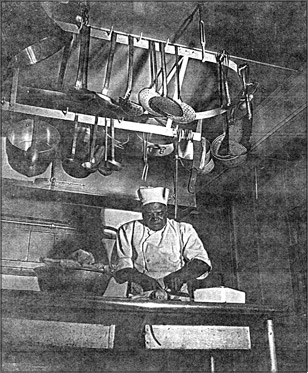 Photograph courtesy of the National Archives.
Photograph courtesy of the National Archives.
There are three main places for seamen to work on a ship—in the galley (where food is prepared), in the engine room, or on deck. African-American seamen were for the most part relegated to work in the galley until the 1930s, when the NMU began to challenge segregation on board.
At Work on Deck
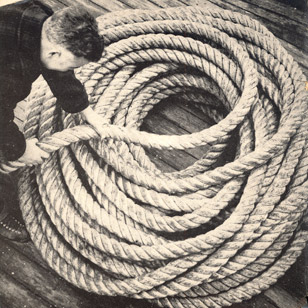 Photograph from Gottlieb, This is the NMU (1956), courtesy of Tamiment Library, New York University.
Photograph from Gottlieb, This is the NMU (1956), courtesy of Tamiment Library, New York University.
Working on deck meant you were always exposed to the elements.
At Work in the Engine Room
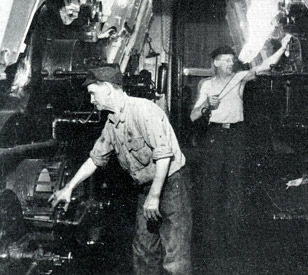 Photo from Men and Ships (1937), courtesy of Tamiment Library, New York University.
Photo from Men and Ships (1937), courtesy of Tamiment Library, New York University.
Working in the engine room was frequently hot and dangerous.
The Shape-Up
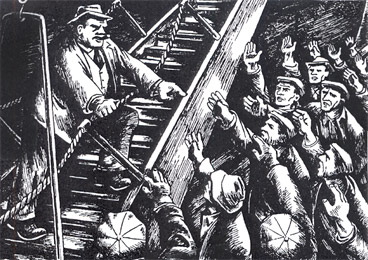 Drawing by Bits Hayden, from Mike Quin, The Big Strike (1949), courtesy of Tamiment Library, New York University.
Drawing by Bits Hayden, from Mike Quin, The Big Strike (1949), courtesy of Tamiment Library, New York University.
Traditional hiring practices like the shape-up were both exploitative and unfair—men paid bribes for jobs, waited on piers for hours, pushed through a crush of men to catch the eye of the boss.
Seaman Julius Margolin: I’ve done both—shaped up on the pier, when we were treated like slaves, and lined up in the union hall to ship out. The difference was amazing.
Crowded Fo’c’s’le
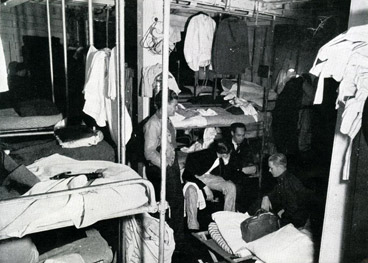 Photograph from Men in Ships (1937), courtesy of Tamiment Library, New York University.
Photograph from Men in Ships (1937), courtesy of Tamiment Library, New York University.
Strike veteran Joe Stack speaking at Cooper Union, Nov. 3, 1986 (on the 50th anniversary of the Fall Strike):
I started going to sea in 1931 at the age of 15. I came from the Society of St. Vincent Paul, a Catholic orphanage. I was pro-union, anti-communist. I many times wondered later why I was so anti-communist. But I think my teacher had a lot to with it, in the public school in Richmond, Michigan at the age of 9…
They used to give a little recital to get your attention at that particular time instead of the prayer. So she give us some short story, about how the communists tried to burn down the capital of Lansing, Michigan, where I come from. I come from Detroit. And I thought at the time, “Why those dirty bastards. Why would they do a thing like that.” And apparently that must have stuck in my mind because for a long period of time I was anti-communist.
My first trip to sea, of course, was in 1931, my brother Walter was sailing the ship, the old George Washington, a big coal-burner, that was confiscated from Germany after World War I, the biggest coal-burner on the East Coast. I signed on as an oiler. I’d never seen a ship before. My brother had a friend who was the ex-port engine room delegate. He got me a letter about that long. In those days you had no union backing. I took it to the office they gave it to the shipping board. They gave me another letter. A few days later I was on my way to Hamburg, Germany…
When I first got on the ship, I didn’t hesitate. I was in a fo’c’s’le with 20 coal passers and coal-burning firemen. I kneeled down by my bunk and say my prayers. These guys they all thought I was nuts. They couldn’t understand me. They figured I was some sort of wacko. But anyway that was my teaching. That was my feeling, and… I used to believe. I felt sorry for Protestants. I thought they all went to hell. Only Catholics, only Catholics went to heaven. So anyhow I went on the old George Washington. I made two trips on there. Conditions of course, we could go on all night about what conditions were. But just as one example. This was a passenger ship. And they had all these fine staterooms, suites, and all that.
In the sailors’ quarters we had, like I said, several fo’c’s’les 18–20 guys in them. Each guy, each man was issued a bucket, a galvanized 5-gallon bucket, a regular bucket. That was your possession and you washed yourself out of that bucket. You washed your clothes out of that bucket. There was no hot running water for the crew’s quarters. You had to go, you had a steam pipe in a place there where you’d get a bucket of water, put it underneath the steam pipe, turn the steam on, you’d get hot water, you’d scrub your clothes, wash yourself, and so forth.
When you put your bucket underneath the bunk, the next morning when you’d leave a little water in it—you’d learn not to leave no water, because next morning there were about that many bedbugs dead down in the water, in the bucket. That’s the way conditions were. But I could go on all night describing conditions. I think we’ve all heard about that.
Traditional living and working conditions were just as bad as traditional hiring practices, as illustrated by this image from the 1930s of a crowded fo’c’s’le.
Fo’c’s’le is the sailors’ abbreviation of forecastle—the foredeck of a ship, the section in front of the foremast, where ordinary sailors (as opposed to officers) were quartered.
Deck and engine room seamen slept 20, 30, 40 men to a room. Stewards department “glory-holes” were equally crowded. Three-high bunk beds were common, sagging mattresses were the norm (often stuffed with straw—which seamen jauntily nicknamed “a donkey’s breakfast.”) Bedbugs, lice, and rats proliferated.
Paying Bribes to “Crimps”
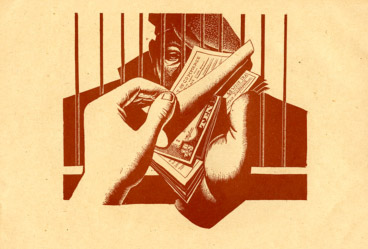 Drawing by Harold Price, from Know the Score (1945).
Drawing by Harold Price, from Know the Score (1945).
Strike veteran Robert McElroy speaking at Cooper Union, Nov. 3, 1986 (on the 50th anniversary of the Fall Strike):
The food always became an item on these ships. At one point the Standard Oil Co. launched a competition to see which of its chief stewards could bring in the lowest per capita feeding costs. The winner spent something like 33 cents per day per man. And we were subjected to such enormities as rotten sides of beef defrosting on deck. You could smell its putrid state. Or the inventive chief steward who would make a week’s allotment of milk by taking a pint can of condensed milk and diluting it in a five-gallon jug of water.
To get a job on a ship, seamen had to either go cap in hand begging a job from the Chief Mate—or pay a “crimp joint” the price of a week’s lodging—and then be hired the next day. Sometimes the local “crimp” was a store that sold seamen the sea boots, oilskins, and other gear they needed. These stores kicked back money to the ship’s officers—who only then were willing to hire the job applicant they had previously rejected. Crimps could also take liens on a seaman’s pay—just one of the many difficulties that faced seamen before the advent of union hiring halls.
Shipping companies went to great lengths to save money, as reported in this account from seaman Robert McElroy.
On the Beach
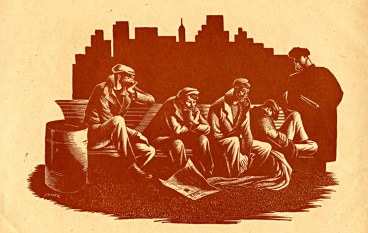 Drawing by Harold Price, from Know the Score (1945).
Drawing by Harold Price, from Know the Score (1945).
The drawing shows weary seamen on a park bench, a threatening police officer looming over them. “On the beach” meant out of work in sailors’ slang. The newspapers they used to look for scarce jobs doubled as blankets on cold nights.
The staggering unemployment of the Great Depression was particularly acute for merchant seamen, since an entry-level job as an “ordinary seaman” required neither skill nor experience. Desperate job-seekers got so weary of sleeping on park benches that they signed aboard ships as “workaways”—paid $1/month, working regular shifts—in hopes a crew member got sick or quit unexpectedly.
Desperate conditions during the Depression spurred a revival of activism and union organizing across the country; legal protections from the newly created National Labor Relations Board helped. Young, left-leaning, first and second generation immigrant organizers built new unions that ultimately formed the Congress of Industrial Organizations (CIO).
Conditions on ships and on the waterfront were worse than ever. Merchant seamen had inherited an aged, inept, weak, and in places corrupt AF of L craft union, the International Seamen’s Union.
The SS California
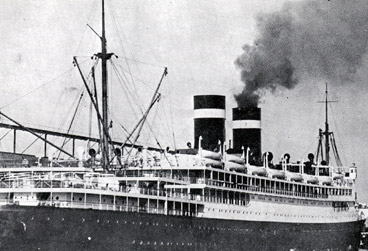 Photograph from Gottlieb, This is the NMU (1956), courtesy of Tamiment Library, New York University.
Photograph from Gottlieb, This is the NMU (1956), courtesy of Tamiment Library, New York University.
When the International Seamen’s Union accepted a new contract in 1936 with no improvements in wages or working conditions, a group of young seamen saw it as a sell-out.
The crew of the SS California, led by Joe Curran, determined to make a change. Using the new strategy of the sit-down strike, they refused to cast off—and refused to disembark—preventing scab replacements from taking their place.
Joe Stack and the striking California crew
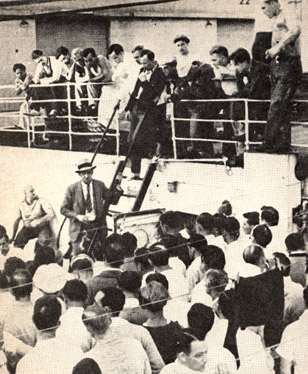 Photograph from Gottlieb, This is the NMU (1956), courtesy of Tamiment Library, New York University.
Photograph from Gottlieb, This is the NMU (1956), courtesy of Tamiment Library, New York University.
Strike veteran Joe Stack speaking at Cooper Union, Nov. 3, 1986 (on the 50th anniversary of the Fall Strike).
In the meantime I joined the rank-and-file seamen’s movement. The International Seamen’s Union. But there was a rank-and-file group that was floating within the union. I joined that there group.
They put a sign on all the docks: “You cannot get a job here unless you belong to the International Seamen’s Union.” The shipowners seen that the MWIU was getting strong and the seamen were ready to get organized. So therefore they jumped in with the international. They were working together and you had to belong to the International Seamen’s Union. So we tolerated it. We dissolved the MWIU and decided to work from within. To take over the old International [Seamen’s Union] and make proper living conditions and so forth for the seamen.
My first main action was in the spring of 1936, although we had a lot of different individual actions—job actions and so forth on different ships. But we got on this here ship, the SS California going inter-coastal—through Havana, Panama Canal, into San Diego, Frisco, San Pedro, and back. When we got to San Pedro, California, I went ashore like most of the other guys and got drunk. And I come back to the ship 2 o’clock in the morning. And our deck delegate, which was Joe Curran, was sitting at the table reading the paper.
And he says to me, “Stack, did you see this here news?”
I said, “What news?”
He says, “The International Seamen’s Union signed a contract for less wages and hours and conditions than the other unions on the West Coast. What do you think we ought to do about this?”
Well the ship was due to sail at three o’clock in the morning. This was two o’clock in the morning.
So I said, “I think we ought to have a meeting.”
So my shipmate Donald Craig and I went ashore, we went to the different gin mills and houses of ill-repute, rounded up the boys, came back aboard the ship, we called a meeting in the deck department headquarters and we said we were going to tie the ship up.
So we voted strike. We went to the captain, told him what we were going to do. He informed us that he was running the ship and that was that.
So about another hour and a half later, the Chief Mate came along. He said, “Let’s single up fore and aft. Let’s go.” This and that.
Nobody moved. To make a long story short, the ship was on strike. But, fortunately, during the period of this here strike, the shipowners and the other officials got together. And they tried to put the fear into the boys, to get them to sail the ship. They put out the word that it was a mutiny. But when they put out that it was a mutiny—that spread out all over the entire coast and all over the world. We kept the ship tied up there for three days.
The striking crew of the SS California listens as an I.S.U. official begs them to give up their sit-down strike in the port of San Pedro. Narrator Joe Stack is visible straddling the railing in the extreme upper right.
Joe Stack: Well, the ship was due to sail at three o’clock in the morning. This was two o’clock in the morning.
So I said, “I think we ought to have a meeting.”
So my shipmate Donald Craig and I went ashore, we went to the different gin mills and houses of ill-repute, rounded up the boys, came back aboard the ship, we called a meeting in the deck department headquarters and we said we were going to tie the ship up.
Frances Perkins
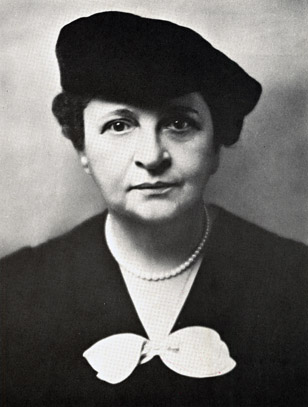 Photograph courtesy of The New York Public Library Picture Collection.
Photograph courtesy of The New York Public Library Picture Collection.
Strike veteran Joe Stack speaking at Cooper Union, Nov. 3, 1986 (on the 50th anniversary of the Fall Strike):
In the meantime we got a telephone call from Washington D.C. from the Department of Labor… Madame Perkins. She said she wanted to speak to our delegate on the phone. Curran and a few of our representatives went out on the dock. Talked to her on the phone. She said, “Lookit. You fellows take that ship back to the East Coast. I guarantee you there won’t be no logs, no discrimination against any of you.”
Well we hemmed and hawed, had meetings on it and so forth. But in the long run, we decided, okay, take the ship back to the East Coast.
The sit-down strategy worked well; US Secretary of Labor Frances Perkins personally intervened, pleading with strike leader Joe Curran, by telephone, to get the California sailing back to New York. She promised to use her influence to increase wages by $5 a month, and to see that there were no recriminations. The ship sailed to New York.
Perkins’ influence, however, was not sufficient, and when they arrived in New York, Curran and 64 other striking crew members were fired and blacklisted.
Spring Strike Confrontation
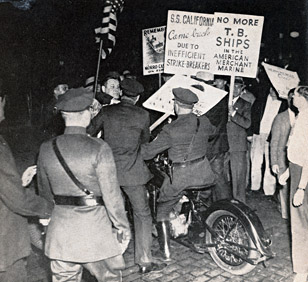 Photograph from Gottlieb, This is the NMU (1956?), courtesy of Tamiment Library, New York University.
Photograph from Gottlieb, This is the NMU (1956?), courtesy of Tamiment Library, New York University.
Strike veteran Joe Stack speaking at Cooper Union, Nov. 3, 1986 (on the 50th anniversary of the Fall Strike):
We sailed the ship, started out at sea. Three days after we got out at sea the yeoman came down with log slips, yellow log slips, three days pay for every day we were alongside the dock for every member of the crew that participated in the strike. That was number one violation on their part. Number two, when we got to New York, they did us the greatest favor that could ever happen to the rank-and-file seamen that had been fighting. …Well when we got to New York they turned around and fired the whole crew. So that was the best thing could ever happen. So it spread like wildfire. We determined right then and there, without consulting the international officials, or anything like that, we decided we’re going to declare a strike.
The Spring Strike began in mid-March, when the SS California returned to New York and the entire deck crew was fired, despite Madame Perkins’s efforts to save the crew from retaliation.
They called a wildcat strike—a strike not sanctioned by the union. What was to become known as the Spring Strike was underway.
Note the picket signs the strikers are carrying as they confront police officers on motorcycles: “No More T.B. Ships in the American Merchant Marine,” and “The SS California came back due to inefficient strike breakers.”
Violence During the Spring Strike
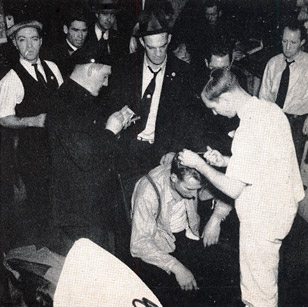 Photograph from Raskin,On a True Course (1967), courtesy of Tamiment Library, New York University.
Photograph from Raskin,On a True Course (1967), courtesy of Tamiment Library, New York University.
The strike lasted nearly 10 weeks, and there was violence throughout. The struggle was intense both within the union and against the ship owners. The ISU, accusing Curran of being a “tool of the Communists,” expelled him, and actually signed up scabs to man the ships during the strike.
Strikers battled shipowners, hostile longshore goons, and at times the New York City Police Department before giving up in May.
Four Strikers During Spring Strike
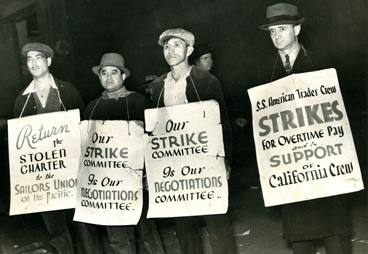 Photograph from the Daily Worker/Daily World Photographs Collection, Box 157, folder 22867, courtesy of Tamiment Library, New York University.
Photograph from the Daily Worker/Daily World Photographs Collection, Box 157, folder 22867, courtesy of Tamiment Library, New York University.
Strike veteran Joe Stack speaking at Cooper Union, Nov. 3, 1986 (on the 50th anniversary of the Fall Strike):
Well time was ripe. The word got out by the grapevine. And the seamen up and down New York Harbor, all the way down to Baltimore—I mean particularly the East Coast. We declared a strike. We knew about agitation. We knew what conditions we were under. We hated the shipowners and all of this, but still that didn’t materialize the strike. Fortunately, when we went out on strike, we did have all the nucleus of the fighters. We had old MWIU guys, we had Wobblies. We had communists. We had every description of radical there was. And they all joined our banner. And we made a united front. So we declared the strike.
We had the strike for 82 days, and after 82 days the strike was petering out because we had no finances.
The only help we had was through the left-wing unions. And I will say this, it’s a matter of record, and I think history will show it, the role that was played by the Communist Party. If it wasn’t for Communist Party on the waterfront there would have been no N.M.U. possibly for another 10 or 15 years.
Twenty-five east coast ships struck in sympathy when the deck crew of the SS California was fired.
The strike increased Curran’s prestige, and strengthened the resolve of many. However, the large numbers dwindled quickly, and eventually the remaining stalwart strikers called off the action.
Joe Curran and many others were determined to continue organizing, despite the long and grueling strike they had just lost. They formed the Seamen’s Defense Committee.
The End of the Spring Strike
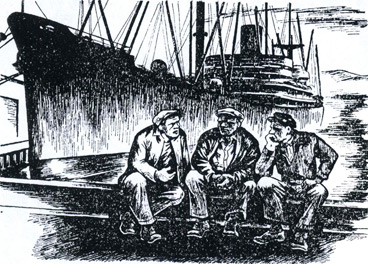 Drawing by Bits Hayden from Quin, The Big Strike (1949), courtesy of Tamiment Library, New York University.
Drawing by Bits Hayden from Quin, The Big Strike (1949), courtesy of Tamiment Library, New York University.
Strike veteran Joe Stack speaking at Cooper Union, Nov. 3, 1986 (on the 50th anniversary of the Fall Strike):
The Spring Strike was over—83 days. When we went off on the Spring Strike we went back and we vowed to come out again in the fall.
So three or four months later we came out again. And we had another strike—and 84 days in the ’36 and ’37 Strike. We lost that strike. But did we give up? We kept struggling. And the word went out: “Go back aboard the ships and organize.” We went back aboard the ships and we set ’em down in every port of the world. And when we set these here ships down, the shipowners finally got the idea. They couldn’t sail the ships. They were losing money. They went into court. They got an injunction against the old International Seamen’s Union that they’d been sleeping with and they ordered the National Labor Board to hold election for all the ships and we had Labor Board elections we won Labor Board elections unanimously.”
As more and more Spring Strikers “voted with their feet” and in desperation crossed through strike picket lines, strikers reluctantly acknowledged that the strike was lost. They vowed to strike again later in the year—with adequate preparations this time.
Joe Stack: We lost that strike. But did we give up? We kept struggling. And the word went out: “Go back aboard the ships and organize.”













